
Endurance racing is a form of motorsport racing which is meant to test the durability of equipment and endurance of participants. Teams of multiple drivers attempt to cover a large distance in a single event, with participants given a break with the ability to change during the race. Endurance races can be run either to cover a set distance in laps as quickly as possible, or to cover as much distance as possible over a preset amount of time.

In motorsports, a pit stop is a pause for refuelling, new tyres, repairs, mechanical adjustments, a driver change, as a penalty, or any combination of the above. These stops occur in an area called the pits, most commonly accessed via a pit lane which runs parallel to the start/finish straightaway of the track and is connected to it at each end. Along this lane is a row of garages outside which the work is done in a pit box. Pit stop work is carried out by the pit crew of up to twenty mechanics, depending on the series regulations, while the driver often waits in the vehicle.
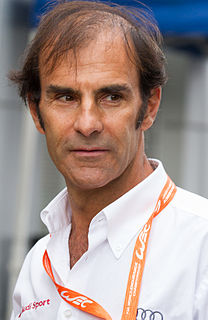
Emanuele Pirro is an Italian racing driver who has raced in Formula One, touring cars and in endurance races such as the 24 Hours of Le Mans which he has won a total of five times. Two times Italian Karting Champion, Formula Fiat Abarth Champion (1980), two times Italian Touring Car Champion, two times Italian Overall Champion and German Touring Car Champion (1996), he also achieved records in endurance racing that place him amongst the best in the discipline, including; five wins in the 24 Hours of Le Mans, two times ALMS Champion, two times winner of the 12 Hours of Sebring, three times winner of Petit Le Mans, winner of the 24 Hours Nürburgring (1989), two times winner of the Macau Guia Race and two times winner of the Goodwood RAC Historic TT. He has taken part in over 500 official national and international races.
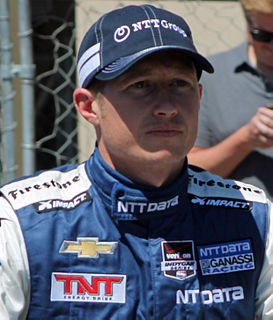
Ryan Briscoe is an Australian-American professional racing driver from Sydney who has predominantly raced open-wheel and sports cars in Europe and America.

The 24 Hours of Le Mans is an endurance-focused sports car race held annually near the town of Le Mans, France. It is the world's oldest active endurance racing event. Unlike fixed-distance races whose winner is determined by minimum time, the 24 Hours of Le Mans is won by the car that covers the greatest distance in 24 hours. Racing teams must balance the demands of speed with the cars' ability to run for 24 hours without mechanical failure.

Road Atlanta is a 2.540-mile (4.088 km) road course located just north of Braselton, Georgia, United States. The facility is utilized for a wide variety of events, including professional and amateur sports car and motorcycle races, racing and driving schools, corporate programs and testing for motorsports teams. The track has 12 turns, including the famous "esses" between turns three and five; and Turn 12, a downhill, diving turn. The track is owned by IMSA Holdings, LLC through its subsidiary Road Atlanta, LLC, and is the home to the Petit Le Mans, as well as AMA motorcycle racing, and smaller events throughout the year. Michelin acquired naming rights to the facility in 2018.
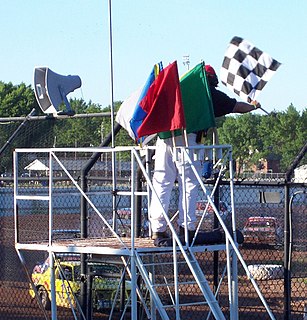
Racing flags are traditionally used in auto racing and similar motorsports to indicate track condition and to communicate important messages to drivers. Typically, the starter, sometimes the grand marshal of a race, waves the flags atop a flag stand near the start/finish line. Track marshals are also stationed at observation posts along the race track in order to communicate both local and course-wide conditions to drivers. Alternatively, some race tracks employ lights to supplement the primary flag at the start/finish line.
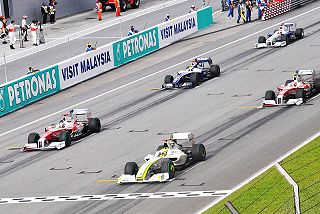
A standing start is a type of start in auto racing events, in which cars are stationary when the race begins.

Jamie Whincup is an Australian professional racing driver competing in the Supercars Championship. He currently drives the No. 88 Holden ZB Commodore for Triple Eight Race Engineering. He has won a record seven Supercars championship titles, four Bathurst 1000 victories, and a Bathurst 12 Hour victory. Whincup is the all-time record holder in the Supercars Championship for race wins, at 123 career wins. He is also the first driver to win the Jason Richards Memorial Trophy twice at Pukekohe Park Raceway in Auckland, New Zealand.
The National Association for Stock Car Auto Racing (NASCAR) makes and enforces numerous rules and regulations that transcend all racing series.
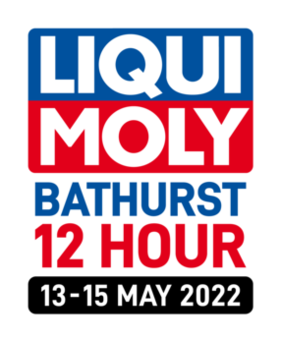
The Bathurst 12 Hour, currently known as the Liqui Moly Bathurst 12 Hour for sponsorship reasons, is an endurance race for GT and production cars held at the Mount Panorama Circuit, in Bathurst, Australia. It is an annual race, taking place every February. The race was first held in 1991 for Series Production cars and moved to Sydney's Eastern Creek Raceway in 1995 before being discontinued. The race was revived in 2007, again for production cars, before adding a new class for GT3 and other GT cars in 2011. This has led to unprecedented domestic and international exposure for the event. In all, eighteen races have taken place; seventeen at Mount Panorama and one at Eastern Creek Raceway.

Shane Robert van Gisbergen is a New Zealand racing driver who competes in the Repco Supercars Championship. He currently drives the No. 97 Holden ZB Commodore for Triple Eight Race Engineering.

Race results from the automobile and motorcycle races contested at the Indianapolis Motor Speedway in Speedway, Indiana. Races have been held on seven different track configurations:
The following is a glossary of terminology used in motorsport, along with explanations of their meanings.

Stefan Mücke is a German professional racing driver.

William Stevens is a British racing driver, who formerly competed in Formula One, Eurocup Formula Renault 2.0, Toyota Racing Series and the British Formula Renault Championships. In Formula One, he made his debut at the 2014 Abu Dhabi Grand Prix with Caterham F1, replacing Marcus Ericsson for the double points race. During the 2015 season he competed with the Manor Marussia F1 Team.
Index of Effluency is the top prize awarded in the 24 Hours of LeMons automotive racing series. General criteria to win this award is a car that is too unreliable to be driven effectively on the streets yet manages to complete a decent number of laps on the race track. IOE can be awarded to a vehicle that was deemed unreliable from the factory or a more reliable car with an unwise engine transplant. The award is named after the "Index of Thermal Efficiency", a prize briefly given in LeMons' namesake the 24 Hours of Le Mans to the car that scored the highest based on a complex formula that took into account car weight, fuel usage and average speed.

The 2014 International V8 Supercars Championship was an FIA-sanctioned international motor racing series for V8 Supercars. It was the sixteenth running of the V8 Supercars Championship and the eighteenth series in which V8 Supercars have contested the premier Australian touring car title.

William Ryan Johnson is an American professional sports car and stock car racing driver. He is the 2016 IMSA Continental Tire Sports Car Challenge GS champion. He currently competes part-time in the WeatherTech SportsCar Championship and FIA World Endurance Championship, driving for Ford Chip Ganassi Racing UK in the No. 66 Ford GT.

The ChampCar Endurance Series is a budget class endurance race held on paved road race courses across North America, formerly known as the ChumpCar World Series, run by ChumpCar International Inc. Founded in 2009, the range changed its name in 2017, with registered trademark granted by the USPTO on August 28, 2018. Chumpcar was a parody of the now defunct Champ Car World Series, an open wheel professional racing series that has since developed into the Indycar Series. The initial concept was an endurance racing series for cars of $500 in value or less similar to the 24 Hours of LeMons endurance racing series. The series has a different overall philosophy, however, placing more emphasis on racing and less on decorations, costumes, and themes. ChumpCar's slogan is "Real Racing, Real Tracks, Real Cheap Cars", and its stated mission, as stated on its website, is to be "It's all about racing. It's all about tearing down those high-dollar roadblocks that, in the past, have restricted people with a passion for cars and racing from getting fully engaged and involved in motorsports. It's about enjoyment, friends and bringing road racing back to where it was fifty years ago - when racing was fun, cheap and nobody cared whether you had Snap-On tools or a mix-match of hand-me-downs in your toolbox." Competitors generally refer to themselves as "Chumps".





















